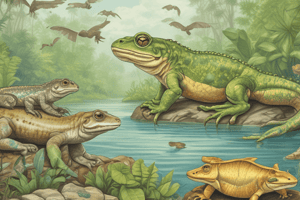Podcast
Questions and Answers
What is a defining feature of amphibians?
What is a defining feature of amphibians?
- Scales for protection
- Feathers for flight
- Moist skin that absorbs oxygen (correct)
- Dry skin that prevents dehydration
During their metamorphosis, most amphibian species develop what to become fully terrestrial beings?
During their metamorphosis, most amphibian species develop what to become fully terrestrial beings?
- Gills for underwater breathing
- Fins for swimming
- Lungs for respiration (correct)
- Wings for flight
Where do amphibians lay their eggs depending on the species' adaptation?
Where do amphibians lay their eggs depending on the species' adaptation?
- In the nests of other animals
- In underground burrows
- In water or on land (correct)
- On leaves of trees
Which stage of the amphibian life cycle involves developing limbs, lungs, and other adult structures?
Which stage of the amphibian life cycle involves developing limbs, lungs, and other adult structures?
What role do many amphibians play in ecosystems?
What role do many amphibians play in ecosystems?
Which of the following is NOT a characteristic of amphibians?
Which of the following is NOT a characteristic of amphibians?
What differentiates amphibians with direct development from those with indirect development?
What differentiates amphibians with direct development from those with indirect development?
Where can amphibians be found in terms of habitats?
Where can amphibians be found in terms of habitats?
Which amphibian species is mentioned as preferring moist forests?
Which amphibian species is mentioned as preferring moist forests?
What is the primary role of amphibians as mentioned in the text?
What is the primary role of amphibians as mentioned in the text?
Which type of amphibians have a scaleless, slithering body?
Which type of amphibians have a scaleless, slithering body?
Why are amphibians considered valuable indicators of pollution and climate change?
Why are amphibians considered valuable indicators of pollution and climate change?
Flashcards are hidden until you start studying
Study Notes
Amphibians: An Intriguing and Diverse Group of Animals
Amphibians are a group of animals characterized by their unique life cycles, which involve both terrestrial and aquatic environments. These creatures possess several distinctive features that make them stand out from other animal classes. In this article, we will delve into the fascinating world of amphibians, exploring their characteristics, life cycle, different species, habitats, and the important role they play in our ecosystems.
Characteristics
A defining feature of amphibians is their skin, which is moist in the larval stage and can absorb oxygen directly. This allows them to breathe underwater while also maintaining hydration. However, during their metamorphosis process, most amphibian species develop lungs, becoming fully terrestrial beings with the ability to regulate moisture levels through their respiratory systems.
Another intriguing aspect of amphibians is their reproductive strategies. They lay eggs in water or on land, depending on the species, and many exhibit parental care behaviors, such as guarding or brooding their offspring.
Life Cycle
The life cycle of amphibians can be divided into four stages: egg, tadpole, juvenile, and adult. Eggs are laid either in water or on land, depending on the species' environmental adaptation. Once hatched, the tadpoles undergo a series of transformations, including developing limbs, lungs, and other adult structures, to become juvenile amphibians. Finally, these juveniles grow into fully independent adults.
While all amphibians undergo metamorphosis, the time it takes and the form it takes can vary depending on the species. Some species, like some species of salamanders and frogs, have a direct development, meaning the larval stage is not visible. Other species, such as frogs and toads, have an indirect development, with a distinct tadpole stage before metamorphosis.
Types of Amphibians
Amphibians are a diverse group, with over 6,000 known species across the globe. Some of the most well-known amphibians include frogs, salamanders, and caecilians, which are characterized by their scaleless, slithering bodies.
Amphibian Habitats
Amphibians can be found in a wide range of habitats, including forests, grasslands, wetlands, and deserts. Some species, like the American bullfrog, inhabit agricultural areas, while others, like the red-backed salamander, prefer moist forests.
Importance of Amphibians
Amphibians play a crucial role in the ecosystem as indicators of environmental health. They are among the first species to be affected by environmental changes, making them valuable indicators of pollution and climate change. Additionally, many species of amphibians are prey for other animals, making them an essential part of the food chain.
In conclusion, amphibians are a fascinating group of animals that exhibit unique characteristics and a complex life cycle. From their diverse species to their important role in the ecosystem, these creatures remain an intriguing subject for further study and conservation.
Studying That Suits You
Use AI to generate personalized quizzes and flashcards to suit your learning preferences.




